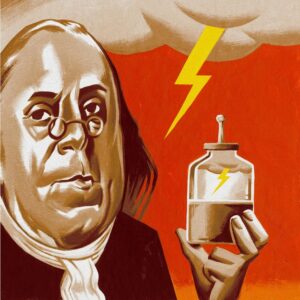Historically Speaking: Humanity’s Long Quest to Bottle Energy
The first batteries produced bursts of power. Making them last has been the work of centuries.
April 1, 2022
Electric cars were once dismissed as a pipe dream. Now experts predict that by 2025, they will account for one-fifth of all new cars. Helping to drive this revolution is the once-humble battery. Today the lithium-ion battery powers everything from phones to planes. The next generation of advanced batteries may use sulfur, silicon or even seawater.
Humans have long dreamed of capturing the earth’s energy in portable vessels that can deliver continuous power. The two-thousand-year-old “Baghdad Battery,” which disappeared from the National Museum of Iraq in 2003, consisted of an iron rod surrounded by a copper cylinder inside a clay jar. When filled with an electrolytic solution such as vinegar or grape juice, the jar produced a tiny amount of energy. Whether this was by design or a coincidence no one can say.

ILLUSTRATION: THOMAS FUCHS
The ancient Greeks observed that rubbing fur against amber produced enough static electricity to move light objects. In the late 16th century, the English scientist William Gilbert experimented with compasses, concluding that the phenomenon discerned by the Greeks wasn’t the same as magnetism. He called this unknown force “electricus,” from the Greek “elektron,” meaning amber.
Creating little bursts of electricity was one thing; figuring out a way to store it was another. To this end, between 1744 and 1746 the Dutch scientist Pieter van Musschenbroek and German Ewald Georg Von Kleist separately developed what became known as the Leyden jar, essentially a metal-lined glass vessel containing water and a conducting wire. Six years later, Benjamin Franklin used one in his famous kite experiment to prove that lightning was a display of electric conduction. He realized that Leyden jars could be linked together to form what he termed a “battery” to create a bigger charge.
Leyden batteries contained just a single burst of energy, however. Scientists still sought to create a more continuous power source, but to do it they needed to understand how electricity was generated. In the late 18th century, the Italian scientist Luigi Galvani mistakenly believed that his electrical experiments on frogs’ legs revealed the existence of “animal electricity.”
His fellow Italian, Alessandro Volta, wasn’t convinced. To prove Galvani wrong, he demonstrated in 1800 that he could create a continuous current via his “voltaic pile,” consisting of copper and zinc discs interleaved with brine-soaked cloths. Volta’s experiments led to the invention of the first chemical battery, which worked on the same principle, using metals soaked in an acidic solution to generate an electric current. This technology made all kinds of little mechanisms possible, such as telegraphs and doorbells.
In 1859 the Frenchman Gaston Planté made a vast improvement to battery life with the first rechargeable lead-acid battery. Although it could power larger objects such as cars, the lead-acid battery was excessively heavy and prone to corrosion.
Thomas Edison believed he could corner the nascent car market if only he could build a battery using different technology. After repeated failures, in 1903 he announced with great fanfare his nickel-alkaline battery. It was the power cell of the future: light and rechargeable. By 1910, when Edison was finally able to begin mass production, Henry Ford had already introduced his cheap Model T car with its polluting, gas-guzzling internal combustion engine. No one wanted Edison’s more expensive version.
Timing is everything, as they say. Edison might have lost the first battle for the battery-powered car, but from the perspective of 2022, he may yet win the war.
